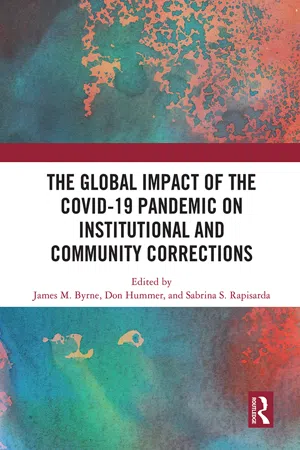
The Global Impact of the COVID-19 Pandemic on Institutional and Community Corrections
- 580 pages
- English
- ePUB (mobile friendly)
- Available on iOS & Android
The Global Impact of the COVID-19 Pandemic on Institutional and Community Corrections
About This Book
The authors of the chapters included in this volume provide preliminary answers to questions such as:
-
- How extensive were COVID-19 outbreaks in prisons, jails, and community corrections systems globally? Which regions and countries reported the largest outbreaks?
-
- Why were prisons and jails found to be "hot spots" for the spread of COVID-19 in most countries?
-
- How did governments initially respond to COVID-19 outbreaks in their corrections systems?
-
- Did the mitigation strategies used in each country reduce the spread of the infection in the corrections system (both in prisons and jails, and in community corrections)?
-
- Did the corrections-focused mitigation strategies used in each country have a positive or an adverse impact on public health and public safety?
-
- How likely is it that the varied short-term mitigation strategies implemented by governments will result in long-term changes in corrections policies and practices?
The book includes three chapters examining the global impact of the COVID-19 outbreaks, six regional overviews, and 27 country-specific reviews, including reviews targeting 21 of the 50 largest prison systems globally. This collection will be an excellent resource for researchers, policymakers, practitioners, and the general public interested in knowing more about the nature and extent of COVID-19 outbreaks in corrections systems globally, and about the diversity of responses developed and implemented by governments from each global region.
The chapters in this book were originally published as a special issue of the journal Victims & Offenders.
Frequently asked questions
Information
Global Impact Assessment
The Global Impact of the Pandemic on Institutional and Community Corrections: Assessing Short-Term Crisis Management and Long-Term Change Strategies
Introduction
Table of contents
- Cover
- Half Title
- Title Page
- Copyright Page
- Table of Contents
- Citation Information
- Notes on Contributors
- Introduction
- Global Impact Assessment
- Africa Regional Overview and Reports from Kenya and South Africa
- Asia Regional Overview and Reports from China, South Korea, Pakistan, India, and the Philippines
- Latin and South America Regional Overview and Reports from Mexico, Argentina, Columbia, Chile, Brazil, El Salvador, Guatemala, and Honduras
- Europe Regional Overview and Reports from Spain, Portugal, Italy, Germany, Russia, Romania, Sweden, and the United Kingdom
- North America Regional Overview and Reports from USA and Canada
- Oceania Regional Overview and Reports from Australia and New Zealand
- Index